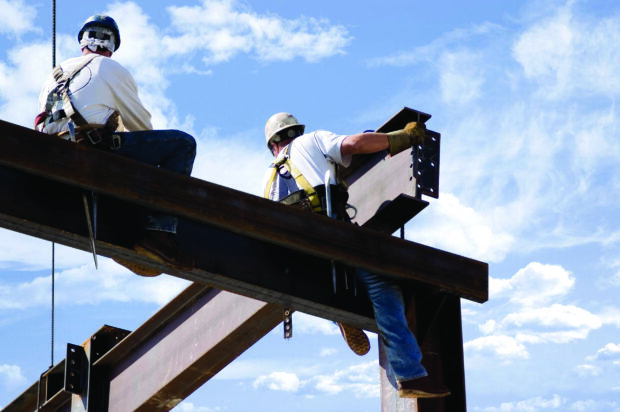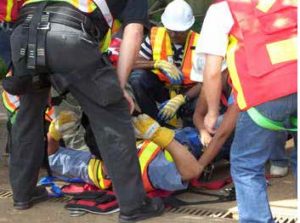HOME | ABOUT US | MEDIA KIT | CONTACT US | INQUIRE
HOME | ABOUT US | MEDIA KIT | CONTACT US | INQUIRE
As the construction sector picks up employment steam, builders focus on instilling a culture of safety in a new cohort of workers.

Five years ago, JE Dunn Construction—one of the nation’s largest general contractors, and the biggest to call Kansas City home-— was riding high with its reputation for job-site safety. It had invested heavily over the years to drive the safety message home, it had a 2011 Experience Modification Rate of 0.54 (a safety metric nearly twice as good as the industry average), and it was the 2012 winner of the Association of General Contractors’ National Construction Safety Excellence Award.
Then, says Midwest Division President Dirk Schafer, reality set in. A pair of major clients, including Intel, informed the builder that, as Schafer delicately recalls, “our safety sucked.” After diving deep into those concerns, the company realized that while it had an extensive safety program, it didn’t have what it needed: “A safety culture,” Schafer says.
And this, at an industry best-practices leader. Thus began a long process of introspection, consultations with process-improvement experts, evaluations and changes in training and workplace communication to create that very culture at JE Dunn. “A safety program,” says Schafer, “is all about compliance; a safety culture is about changing behaviors.”
Dunn’s success in doing just that is particularly relevant these days. The Labor Department reported that no other business sector hired more people in February than construction. Amid and immediately following the Great Recession, the sector shed as much as 40 percent of its work force, by some estimates. A great many of those individuals either retired early or found work in other, less cyclical lines where they could count on steady paychecks.
Some of those may have found their way back to the job site, but if construction is indeed adding tens of thousands of jobs a month from outside those ranks, a significant share of them is donning the hard hat without the career immersion in safety instruction that their predecessors had. And without changes in company cultures—including a very visible buy-in from the leadership—contractors that aren’t upgrading their safety-instruction will soon find that the old ways of doing business aren’t having the intended effects, executives say.
Assessing what he’s seen across the sector, Harmon Construction CEO Tim Harmon worries, because “it seems like so many are untrained not just in safety, but competency in the trades,” and construction is attracting people who don’t have the best training.
For his company, that has meant a new emphasis on what he calls “continuous maintenance.” “You can tell someone they’re supposed to have safety glasses, hard hat and high-visibility vest or shirt, but then leave that area or site and come back a half hour later, and the safety director is telling you that guys don’t have those. People have to be trained, and they have to have awareness.”
His company has a safety consultant who visits job sites frequently, documents any infractions with images or photos, and issues a report out to Harmon himself, along with project managers. “We’ve invested in that. We’re also looking at our safety program for incentives” because until recently, he said, the emphasis has been on the business end of a carrot-and-stick approach.

Every Contractor’s Nightmare | Workplace injuries in the construction sector are often far more serious than in most other lines of work, and the costs involved make site safety a prime consideration for companies in that sector.
At McCarthy Building Companies, Kevin Maitland is vice president for safety, and he, too, sees an influx of workers who present safety challenges. “Overall, the numbers indicate that people are coming in that really don’t have experience in construction at all,” he said. To compensate for that, he said, McCarthy has adjusted its programming to focus on hiring at the front end.
“You’ve got one chance for a good impression when a guy comes in the front gate,” Maitland said. “That safety orientation has to be meaningful. It’s really important that we set the expectation from Day One.” Driving that are videos, site-specific safety plans, task-hazard analyses and even stretching/flexing warm-up drills. A recent tweak, he said, was ensuring that job superintendents are bringing a personal message to orientation sessions.
“Our supers have been in the trades for a long time, and their view of safety in construction is priceless,” he said.
Making the transformation to a safety culture also means follow-through, Schafer noted. Dunn’s after-incident reporting process puts the company’s top executives in the room with site managers explaining what has happened. Moving to quash fears that it could be a visit to the principal’s office—or even a career-ending meeting—the company executives keep the discussion focused on process, rather than blame-making. And not just for accidents, he noted: “There’s a great benefit from studying the near-misses, too.”
The nature of construction work can pose challenges in driving a safety message across a job site, executives say, since subcontractors with their own safety protocols may not be as familiar with the general contractor’s standards and procedures. Among his own staff, “our folks don’t have a problem,” Harmon said. “They get a warning, and the next time, they’d be off the job—they wouldn’t have a job.” He believes that the biggest potential for slippage involves subs on the site. “Some are companies that really put a high priority on worker safety,” he said. “You can tell when they show up—they have their PPE (personal protection equipment), and they’re ready to work and work safely. Then there are people, in certain trades, that tend to be more relaxed and less safety-educated.”
But with some, Schafer says, “we’re seeing certain trade partners way ahead of us” with their own safety protocols.
Timing of that safety message is key, Maitland said. “We know from our data that new employees historically are much more likely to get injured in the first three months of employment. That is why we’ve got to make a special emphasis during those first months.”
McCarthy does so with new training tools and by assigning a mentor to each new employee for those 90 days. That person, he said, “has daily contact with that employee, a special message on things that potentially cause big problems in construction—falls, getting caught between electrical hazards, things that have impact on worker safety and longevity with a peer-to-peer discussion,”
Perhaps a broader message on workplace training, executives say, is that even a well-honed message on methods and processes can be deceptively inadequate. The perspectives of outside consultants can shake an executive’s confidence that even a strategically updated training regimen could be overlooking obvious ways to
improve processes.
Once JE Dunn began digging into the effectiveness of its own training, Schafer said, various metrics showed that top-tier executives were well-versed in safety protocols. Further testing showed project managers close to those levels, but slightly behind. And additional rounds found that three workers in 10 simply hadn’t absorbed the message. “When only 70 percent of the work force said safety matters, we knew we had to do something,” Schafer said.
In the end, driving the safety message is one that comes down to leadership, he said, and that’s one reasons the metrics have shown pronounced improvement at JE Dunn, driven by the leadership’s own safety mantra: “Everyone. Everywhere. All the time.”
When there’s an injury, on a McCarthy job site, Maitland said, “whoever the building owner is, whoever the sub is—it’s not them, it’s McCarthy. We take responsibility for that, and we train to make sure we don’t have those situations. We tell them in orientation, they are vital to our work, and we want them to be partners. They’re jumping into something new, but we can get them there—safely.”